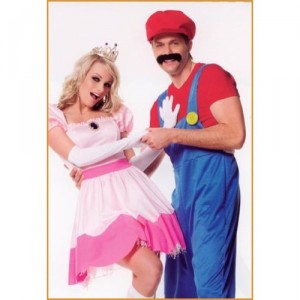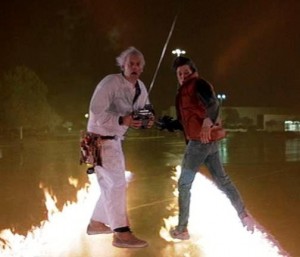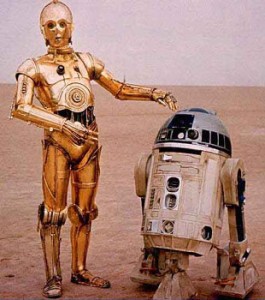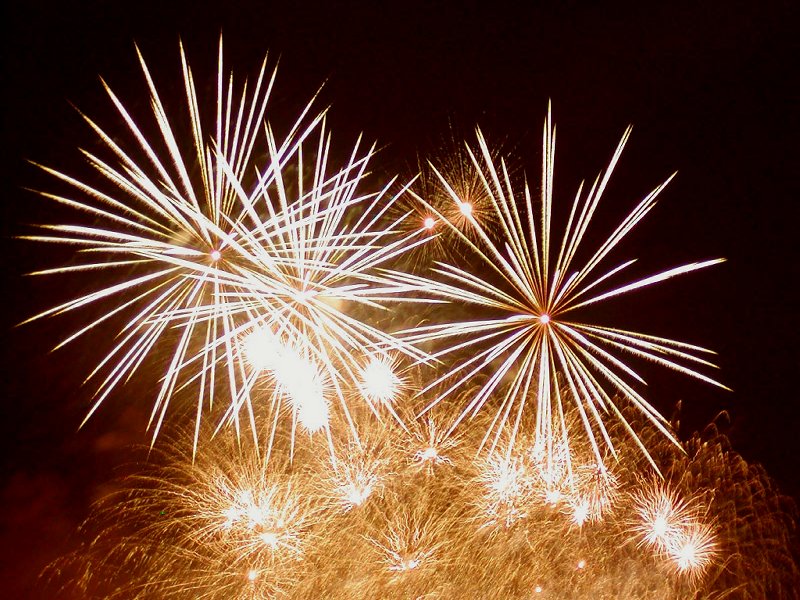The Most Wonderful Time of the Year
As nice as Christmas is, as enjoyable as Thanksgiving can be, my very favourite holiday is New Year’s.
My affinity for it is partly genetic. My Scottish ancestors would, of course, go to church on Christmas but they wouldn’t exchange presents until Hogmanay– the Gaelic word for New Year’s Eve – and then they'd party until the early morning. New Year's Eve was the biggest celebration of the year.
In fact, my grandparents’ generation was the first one in my family to open presents on Christmas morning. I was raised with the annual tradition of first footing, a ceremony I look forward to every year.
But what I like most about NYE is that unlike other holidays it looks ahead to the future. Thanksgiving, Easter, Valentine’s Day, Canada Day, whatever, they’re all anniversaries or commemorate past events. They all invite retrospection and contemplation of the past. That’s good and necessary, but it doesn’t always encourage progress.
New Year’s, on the other hand, is filled with optimism. Sure, you can reflect on the past year, but the emphasis is on planning and hoping for the best in the next 365 days. There’s a blank slate ahead of you and December 31st is your day to figure out what you’re going to create. On January 1st, you put that plan in to motion.
As you'd expect, I’m pretty crazy about resolutions. I probably average a dozen every year, covering every aspect of my life. I always make sure I’ve got at least one resolution for my health, personal relationships and my career. I like to be thorough.
Kathryn Schulz’s “Even absurd new year's resolutions do you good” in today’s Guardian reaffirmed my love of the resolution.
“Our resolutions are not failed acts of the will, but successful acts of the imagination. You will not enrol in a doctoral programme and spend more time with your kids and lose 20 pounds in 2011 just by resolving to do so. But you will be far more doomed to fail - and far more emotionally impoverished - if you never even dream up those plans in the first place.
“That’s why our resolutions, even at their most delusional, strike me as the best possible way to start a new year. They bring us back in contact with all the phantom versions of ourselves, those reverse ghosts that haunt our future, waiting to be embodied. Just as other forms of wrongness as optimism propel us out of bed the morning after a wasted day, our annual resolutions propel us into a new year, hopeful all over again that we will be better people in the days to come.”
It’s that recommitment to one’s self that I find so appealing. It’s something that anyone can do. It doesn’t matter if you’re religious or an atheist. Your age, race, gender or sexual preference are inconsequential.
Refocusing and reconsidering one’s life are all-inclusive pursuits and healthy ones to boot. Unlike other holidays, New Year’s Eve transcends all the cultural divisions we place on ourselves. It’s more accessible than any other day of the year and an opportunity to create some positivity in our lives.
New Year’s is a universal celebration.
I love that feeling of renewal and rejuvenation and I hope that after reading this post you take a few minutes today or tomorrow to evaluate and plan your new year.
All the best to you and yours and have a happy and productive 2011.
World Hockey Summit – Day 4
 The fourth and final day of the 2010 World Hockey Summit focused on moving hockey forward and continuing to spread the good word about Canada’s favourite sport.
The fourth and final day of the 2010 World Hockey Summit focused on moving hockey forward and continuing to spread the good word about Canada’s favourite sport.
After an early breakfast the conference met in the Toronto Sheraton’s downstairs hall to listen to players, coaches and organizers speak about the movement to promote women’s hockey.
Like the previous day’s sessions on the Olympics and a World Hockey Agenda, all the members of the panel acknowledged that the 2010 Vancouver Games had done wonders for their sports’ public profile.
However, unlike Wednesday’s slanging match, keynote speaker Hayley Wickenheiser and the panel of Mel Davidson, Mark Johnson, Arto Sieppi, Angela Ruggiero and Peter Elander all agreed that women’s hockey had to return to the Olympics as well as stage more international and even professional matches.
Ruggiero made an important point about high calibre women’s play: as a member of Team USA she plays, on average, ten games per year. That’s it.
Once a player graduates from the NCAA, there is no viable professional women’s league. An individual looking to improve their game beyond the confines of a varsity program has to arrange her own ice time and practicemates, a surprisingly difficult task.
This lead to a lengthy discussion amongst the panel, and later amongst the break-out groups, about how to go about creating a professional women’s league that would allow elite female players to hone their skill and provide aspiring hockey players with ready-made heroes.
Promoting hockey to women dovetailed perfectly with the afternoon’s session on Growing Participation in hockey.
Tommy Boustedt of Sweden, Sieppi (again) of Finland, Scott Smith of Hockey Canada and Pat Kelleher of USA Hockey all discussed the particular challenges of promoting hockey in their respective countries.
Both Sweden and Finland focus on education of coaches, players and parents through intensive hockey schools open to all amateur players, while USA Hockey is concerned with branching out past the Three Ms: Michigan, Massachusetts and Minnesota.
Canada, of course, doesn’t have to worry about popularizing the game or breaking into new markets. Instead, their focus is on developing accessibility for low-income families and New Canadians as well as promoting women’s and sledge hockey.
Dr. Paul Dennis of the Canadian Hockey League, Cyril Leeder of the Ottawa Senators and John McDonough of the Chicago Blackhawks also contributed by addressing how their organizations interact with local communities to promote hockey and win over new fans to the game.
Although it was the least exciting of the presentations, that final session served as a fitting end to four days of hockey talk. It put a positive spin on the Summit and insured that the hundreds of delegates would be energized to go out and continue their hard work.
World Hockey Summit: Day 3
 Debate over the National Hockey League’s role in international hockey, especially the Winter Olympics, built to a crescendo at the World Hockey Summit yesterday.
Debate over the National Hockey League’s role in international hockey, especially the Winter Olympics, built to a crescendo at the World Hockey Summit yesterday.
International Ice Hockey Federation President Rene Fasel had started thumping the war drums on Tuesday when he warned the NHL that they would expand to Europe “over his dead body”.
During that same question and answer session with TSN’s Gord Miller he called for professional hockey players to play at the 2014 Winter Olympics at Sochi, Russia.
Wednesday morning there was an evaluation of the 2010 Olympics, with Fasel, Vancouver Organizing Committee CEO John Furlong and International OIympic Committee member Timo Lumme speaking about the great success and popularity of hockey at this year's Games.
All three emphasized that the 114 million worldwide viewers of the USA-Canada men’s hockey final had been drawn, in part, by the fact that it was a best-on-best game that featured NHLers.
After the keynotes were done, Miller, acting as moderator, allowed IIHF member Igor Kuperman, sports marketing guru Brian Cooper, Detroit Red Wings general manager Ken Holland, Ottawa Senators captain Daniel Alfredsson and New Jersey Devils captain Jamie Langenbrunner to respond.
Not surprisingly, all five panellists supported the NHL’s return to the Olympics, with only Holland showing any kind of hesitation. The successful GM had many concerns about scheduling and injury issues affecting the success and health of his professional club.
When discussion broke out amongst the hundreds of delegates in attendance, there was an easy consensus that the NHL and Olympics need each other for the fans and the good of the game.
After lunch, NHL Commissioner Gary Bettman had a Q+A with TSN’s Pierre Maguire. During the interview Bettman repeatedly said there were pros and cons to sending his players to Sochi.
“We haven’t said ‘no,’” said Bettman. “And anybody who suggests that we’ve made a decision or suggests I’m anti-Olympics doesn’t get it, because what we’ve been simply saying is, ‘it’s a mixed bag.’”
Bettman stressed that he was commissioner when the NHL first started playing in the Olympics at Nagano, Japan, four cycles ago and that he has always been interested in exposing the sport to as many people as possible.
Many had expected that Bettman’s half-hour session was going to be the most heated event of the day. However, it was the follow-up discussion of a Global Event Agenda that was really contentious.
Moderated by Darren Dreger, the panel began with a thoughtful presentation by Edmonton Oilers associate coach Ralph Krueger, who had served as head coach of the Swiss national team at the Vancouver Olympics.
Krueger proposed a new schedule for international events, featuring the Olympics every four years, a World Hockey Championship during the intervening years and an under-23 world championship during Olympic years.
He also suggested that the Victoria Cup, an annual club championship between two European teams and two NHL teams, should be revived.
Miller then opened the floor to the panel of NHL Deputy Commissioner Bill Daly, Kontinental Hockey League President Alexander Medvedev, Team USA and Toronto Maple Leafs GM Brian Burke, NHL alum Anders Hedberg, former NHL goaltender and prominent NHLPA member Glenn Healy, NHLPA representative Mike Ouellet and IIHF member and broadcaster Paul Romanuk.
Although things began reasonably as each panellist said their piece, Fireworks ensued when they had the chance to rebut each other.
Generally speaking, Burke and Daly presented the case for the NHL staying out of the Olympics, highlighting that it put teams’ assets – the players – at considerable risk of injury. They were also concerned that the interruption in the professional season damaged the momentum of small-market teams.
“The Olympics don’t hurt the Toronto Maple Leafs, it doesn’t hurt our business model,” said Burke, the former GM of the Mighty Ducks. “But in Anaheim it does. In Nashville, it does. In Florida, it does.”
They were opposed by Healy and Ouellet, who as representatives of the players’ association, felt that their constituency should be allowed to play when and where they wanted, and that practically all NHLers would love to play at the Olympics.
Panellists outside of the labour politics of the NHL like Medvedev, Hedberg and Romanuk also chimed in with their concerns, although all three were adamant that the Olympics should be a “best-on-best” tournament.
The debate laid bare many of the tensions at the highest levels of hockey.
Everything from the ongoing labour disputes between the NHL and NHLPA, the lack of communication between the NHL and IIHF, the competing styles and values of European and North American hockey as well as the emergence of the KHL as a threat to NHL supremacy were all on display.
There were many dramatic moments, including Healy wondering aloud why Burke cared so much about when the World Hockey Championships were scheduled, since the Maple Leafs are always available when the tournament begins in April.
Alliances also shifted quickly in the swirling debate. When a doctor from the IIHF spoke from the floor to correct Healy’s impression that the quality of medical care provided at the Olympics is sub-par, the former Toronto goaltender saw his nemesis Burke leap to his defence.
Similarly, when another delegate called out Burke and Daly saying that it was a simple issue and that he was sick of hearing excuses about NHLers playing in the Olympics, Ouellet and Healy both allowed that it was a complex issue.
Burke was the most energetic debater throughout, taking on all comers from the stage and the floor of delegates, although Daly, Ouellet and Healy were very active as well. It was an exciting and intriguing show that had delegates buzzing for the rest of the day.
Today’s topics will be Women’s Hockey in the morning and Growing Participation. It’s hard to imagine that those panels will be nearly as heated, but you never know.
World Hockey Summit: Day 2
 After nine hours of panels, group work, questions and answer periods as well as informal discussions over food, one thing is clear at the 2010 World Hockey Summit: the amateur hockey system has to change.
After nine hours of panels, group work, questions and answer periods as well as informal discussions over food, one thing is clear at the 2010 World Hockey Summit: the amateur hockey system has to change.
Whether it was cautions from Dr. Steve Norris or Dr. Mark Aubry on the overly demanding training in youth hockey during the morning’s Player Skills Development session or the dire warnings of Czech National Program Director Slavomir Lerner of the talent drain from Europe to North America, it was plain as day that things need to change.
Although it’s difficult to sum up nearly six hours of presentations, the general consensus was that minor hockey associations are too focused on turning young players into National Hockey League superstars, sapping the game of its fun and making it excessively dangerous.
As panellist Brendan Shanahan said “How come I don’t hear about kids playing shinny anymore?”
The speakers spoke of multiple concussions to eight and ten year-olds, massive dropout rates in children’s hockey (44% of American hockey players have stopped playing by the age of nine) and a dwindling European junior system robbed of its best talent by the superior Canadian Hockey League.
During question and answer periods as well as in break-out discussion groups the delegates and officials in attendance at the WHS brainstormed ideas that could make amateur hockey fun again for the casual player, while creating a more practical Long Term Athlete Development plan for adolescents and teenagers who want to become professionals.
The idea that was most popular – garnering a round of applause from the Air Canada Centre’s floor when it was suggested – was raising draft eligibility from 18 to 19.
Many groups of delegates had come up with similar concepts including raising the draft age to 20 or forcing players to stay in midget for a minimum of two years and junior for three. A freeze on all international movement at the junior level was also a common theme.
One radical suggestion was to raise draft eligibility to 19, but allow NHL teams to take 18-year-old players at the cost of two draft picks. So a Sidney Crosby-type player would have cost the Pittsburgh Penguins their first and second-round draft picks.
It was an informative and exciting day of hockey talks, and I’d strongly recommend that you follow the above links to see video of the panel discussions. Also, if you want up-to-date quotes from the day’s events follow me on Twitter.
Today’s discussions will start with an evaluation of hockey’s role at the 2010 Vancouver Olympics, then a Q and A with NHL commissioner Gary Bettman and then finish off with an afternoon session on Establishing a Long-Term Global Event Agenda.
The World Cup should be watched with a grain of salt

Turkey's Arif Erdem, shown here during his playing days for the national team, was arrested two weeks ago for his alleged involvement in match-fixing.
Although the playoffs (hockey and/or basketball, take your pick) still sit between us and the summer, the Canadian Broadcasting Corporation has already begun to promote their coverage of this year’s World Cup of Soccer in South Africa.
There’s a growing an air of excitement surrounding the tournament. After all, it’s the biggest sporting event in the world, even more popular than the Olympics.
Unfortunately, this time around I’m going to be watching the World Cup with a pretty sceptical eye.
My disillusionment began in Dec. 2008 as I read Declan Hill’s The Fix, an investigation into the world of sports fixing by a journalist who used to work with the CBC and the British Broadcasting Corporation.
I reviewed the book on my now defunct blog, but in short: Hill uncovered a far-reaching criminal underworld that exerts its influence over many sporting events. Hill chose to focus his investigation on soccer matches and his findings were startling.
According to him, there are two kinds of match-fixing scenarios.
1) Internal – When a member of a team gives incentives to officials or the players on opposing clubs to give his team an advantage.
Author Joe McGinniss details this kind of fix in The Miracle of Castel Di Sangro when he overhears several players discussing throwing their final game of the season against Bari. They had been asked to do this “favour” to insure that Bari would be promoted to Serie A.
2) External – When an outsider influences the outcome of a match for personal gain.
Obviously, this is the more typical kind of sporting corruption, with the Black Sox scandal, when the Chicago White Sox threw the 1919 World Series at the behest of Arnold Rothstein, serving as a sterling example.
In The Fix, Hill uncovers evidence of many professional matches being thrown world-wide. The climax of the book is when a mobster assures him that the World Cup itself is fixed. The gangster predicts the results of a handful of matches, down to when the goals are scored.
Hill watches with growing horror as each one of the games ends just as described.
Why is this pertinent now? Because last November German police arrested 15 people for fixing more than 200 games. Two weeks ago, Turkish police detained 40 people, including former international Arif Erdem, for their involvement in thrown matches.
Germany’s Bundesliga and Turkey’s Süper Lig are not the best professional soccer league’s in the world, but they are hardly fly-by-night organizations. In fact, the German national team is one of the best sides in the world and a contender for the 2010 World Cup.
With all this in mind, it will be hard to not be cynical when one of the favourites struggles against an opponent this summer. I simply can’t help but be a little jaded after reading The Fix and hearing about recent events in European soccer.
It’s all but official: Beckham’s career with England is over
 With all the excitement of Sunday’s March Madness selections, the news that David Beckham tore his Achilles tendon in the closing minutes of AC Milan’s 1-0 win over Chievo Verona slipped between the cracks.
With all the excitement of Sunday’s March Madness selections, the news that David Beckham tore his Achilles tendon in the closing minutes of AC Milan’s 1-0 win over Chievo Verona slipped between the cracks.
Although the 34-year-old had surgery to repair it almost immediately, orthopedic surgeon Sakari Orava estimates that it will take six months for him to recover.
This rules Beckham out for this summer’s World Cup in South Africa, and probably means the end of his illustrious, although somewhat disappointing, career as a member of England’s national squad.
Given Beckham’s age, the severity of the injury and the fact that he’d already been cut from the English side once, it’s highly unlikely that fans will ever see him in meaningful play for England again. The 2014 World Cup is simply too far away and even the 2012 European Cup squad would be tough for him to make.
Sure, he’ll probably recover and be able to play for the Los Angeles Galaxy again, but Major League Soccer is hardly a big enough stage for one of the most recognizable athletes in the world.
It’s a sad end for one of the best players in English history. Many felt Beckham would be the Chosen One to bring the World Cup back to Old Trafford, but now he’s missing out on his last chance to return the Three Lions to their former glory.
I’ll be the first to admit that Beckham wouldn’t have been a major contributor to the English cause. In fact, just last week I spotlighted him as a player whoI think is past his prime.
However, he’d still be useful as a role player.
Beckham would have undoubtedly helped England in free kick and penalty kick situations, as well as providing invaluable leadership off the pitch. After all, he’s made 115 international appearances, second only to goalkeeper Peter Shilton's 125 appearances for England from 1970-90.
This injury is the most disastrous moment in Beckham’s international career since 1998 when he was sent off in the crucial World Cup match against hated Argentina.
In any event, it’s heartbreaking that Beckham isn’t getting one last kick at the can, one last opportunity to prove himself as one of the best players England has ever produced. He and his fans worldwide deserved the chance to give him a proper send off with the Three Lions on his chest.
Paralympics off to a poor start before they can even begin
 In the wake of the very successful Vancouver Olympics there’s a nice afterglow surrounding Canada’s amateur sports. Events like downhill skiing and curling are given more prominent airtime on television and commentators like ESPN’s Bill Simmons are still talking about the 2010 Games.
In the wake of the very successful Vancouver Olympics there’s a nice afterglow surrounding Canada’s amateur sports. Events like downhill skiing and curling are given more prominent airtime on television and commentators like ESPN’s Bill Simmons are still talking about the 2010 Games.
It’s little wonder. After all, Canada finally got the monkey off its back when Alex Bilodeau won a gold medal, the first time a Canadian has won the top prize on home soil. Canadians then went on to win 13 more gold medals, an Olympic record for the host nation of a winter games, culminating in a dramatic 3-2 overtime victory over Team USA in men’s hockey.
The closing ceremonies struck the right note as well. It was funny, charming and distinctly Canadian, provided you turned the TV off as soon as Nickleback took to the stage.
But all that goodwill is going to be wasted by tonight’s Paralympic Opening Ceremony which you will be able to watch.... nowhere. See, neither CTV or NBC are showing the ceremony live. Instead, they’re going to air the “hit” TV show, Medium, and run the tape of the ceremonies on Saturday.
I understand that the Paralympics don’t have all the glitz and glamour of National Hockey League players or the sex appeal of Lindsay Vonn or the Curlougar Cheryl Bernard, but surely they deserve to have their opening ceremonies live to air.
Can the demand for the latest and greatest episode of Medium really be that high?
To me, the Paralympics do way more to capture the spirit of the Olympics Movement. Their precursor was the Stoke Mandeville Games, organized by Dr. Ludwig Guttmann in 1948 during the London Olympic Games. Orginally, they were an exercise for British World War II veterans with spinal conditions. The hope was that the competition would motivate them to stay active despite their handicap.
The first official Paralympics were held after the 1960 Olympics in Rome with a broadened scope that included anyone with a physical disability or vision impairment. They focused on the participants’ athletic achievements and fitness for the physically disabled around the world.
That is what the Olympics should be all about – the triumph of the human spirit, creating new heroes that people around the world can admire for their determination and will power. It’s a real shame that CTV and NBC have forgotten that lesson just two weekends after the Olympics ended.
Canada/USA has made me into a fan of women’s hockey
 I am embarrassed to admit that last night was the first time I have ever watched a women’s hockey game from start to finish. A terrible sin, I know.
I am embarrassed to admit that last night was the first time I have ever watched a women’s hockey game from start to finish. A terrible sin, I know.
I had seen periods from games or seen bits and pieces, but for a host of reasons I’ve never been able to sit and watch a women’s game to completion. But I’m glad I finally did.
It was the perfect game to watch as Canada held on to an early 2-0 lead to down their arch-rivals from the United States and win their third consecutive Olympic gold medal.
There was a lot to like about the match-up. As the prohibitive favourites in any international tournament, the North American teams had often locked up at the highest levels of competition, whether at the Olympics or World Championships. As a result, the two teams are very familiar with each other’s tactics and strategies.
It quickly became apparent that women’s hockey has a style all its own thanks largely to the prohibition of body checking.
Personally, I’ve always thought this was a sexist rule that implied that women were too fragile to withstand physical play. It just made no sense – why could a woman not safely hit another woman? They would be physical equals, with no particular danger of injury.
However, the lack of big hits means that the scourge of entertaining hockey – the Trap – is impossible. The resulting game is fast and free-flowing with few stops in play. It’s refreshing compared to the National Hockey League where clogging the neutral zone has often been the fastest way to the playoffs.
The players on both teams were exceptional passers and play makers. Throughout the game there were creative tape-to-tape passes generating scoring chances. The Canadians in particular had a knack for finding each other on the ice.
When they had those openings, the Canadians were patient, waiting for defenders to over-commit themselves to a blocked shot. Canada often exploited their opponents’ mistake with a sharp pass for another quality chance. It was inspiring hockey.
Team Canada was also impressively dedicated to defence, dropping to their knees to block shots and passes, fending off a 5-on-3 power play for nearly a minute and a half at the start of the second period.
It was a lot of fun to watch, with both teams evenly matched.
That said, I don’t regret missing any of their other games. They were all lopsided blowouts that made me feel bad for the have-nots in women’s hockey. This is the sport’s greatest weakness – only a Canada-USA match-up showcases the very best of the game. Every other pairing is horribly one-sided.
When the next world championship rolls around, I’ll make sure to watch – as long as the game has Canada and the USA in it.
A side note: The fact that Team Canada had to apologize for their celebratory drinks and cigars on the ice is utter nonsense. The arena had emptied out and they were revelling in their success in what should have been a private moment. They should be allowed to let their hair down, guilt free.
I won’t go on any further, as too much ink has already been spilled over this story.
In Defence of Own the Podium
 Wednesday was Canada’s best day for Olympic medals, with the teams of Kaillie Humphries/Heather Moyes and Helen Upperton/Shelley-Ann Brown winning gold and silver in a 1-2 punch in women’s two-person bobsleigh. The women's 5,000 metre speed skating relay team earned a silver medal. Adding to the medal haul was Clara Hughes, who earned her sixth career Olympic medal, a bronze in 5000m long track speed skating.
Wednesday was Canada’s best day for Olympic medals, with the teams of Kaillie Humphries/Heather Moyes and Helen Upperton/Shelley-Ann Brown winning gold and silver in a 1-2 punch in women’s two-person bobsleigh. The women's 5,000 metre speed skating relay team earned a silver medal. Adding to the medal haul was Clara Hughes, who earned her sixth career Olympic medal, a bronze in 5000m long track speed skating.
Although Team Canada’s 7-3 thrashing of the Russian Federation grabbed all the headlines, it was a banner day for Canada’s less glamorous Olympic sports that may have helped justify the Canadian Olympic Committee’s controversial Own the Podium program, just as it appears to be on its last legs.
Designed to give Canada the highest medal count at the 2010 Vancouver games, the Own the Podium program increased spending on winter Olympic sports by $21-million annually over the course of five years, with money coming from provincial and federal governments as well as private sponsors like Bell Canada. The goal was for Canada to earn a total of 35 podium finishes.
This plan has drawn criticism from all corners. Other countries (particularly the British media) have described it as an “un-Canadian” initiative. Apparently, it’s against the national character to be competitive in anything other than men’s hockey. A proposterous claim given that the Olympics, by definition, is about pushing the envelope and achieving new heights.
At the same time, some domestic media were unhappy that so much public funding - $118 million in total – was being spent on athletics when it could be applied to pressing issues like education, health care or the flagging economy.
As of this writing, Canada has stepped on to the podium 15 times, and might finish in the top three in men and women’s hockey, men and women’s curling and speed skating. Realistically, Canada will finish with around 20 medals, just shy of their 2006 Turin total of 24, and well short of Own the Podium’s stated goal of 35. On Monday, the COC announced that it was no longer aiming to top the medal tables at Vancouver.
In other words, CEO Roger Jackson and his staff have disappointed just about everybody, except the athletes.
Although the program has not met expectations, I think that in the long run it will make Canada into a more formidable sporting nation. At long last, Canadian athletes are getting the support they so richly deserve, allowing them to finally put their best foot forward in international competition.
Their performance at the Vancouver games will serve as an inspiration to Canada’s youth, spawning a new generation of world-class athletes. Yes, the money could have been spent on other projects, but giving Canadian children role models to look up to is certainly a worthy pursuit.
Further, this initiative is just catching Canada up to the rest of the world. In many cases, the athletes from other nations in the winter Olympics are members of the military.
For example, Tuffy LaTour, the coach of Canadian men’s bobsleigh team, is a retired army sergeant from the United States who competed with the American military’s sledding team.
Dan Humphries, the husband of Canadian gold medalist Kaillie Humphries, and a member of Canada’s four-man bobsleigh team, was originally a member of the British Army’s slidding team.
Heck, Finland won the Winter War against the Soviet Union by their superior biathlon skills.
Canada, with its significantly smaller population and military complex, needs a boost to its athletics programs, and Own the Podium is it.
Just as the Calgary Olympics created a home base for Canadian sports, the combination of the Vancouver games and Own the Podium will start a new golden age in the Canadian Olympic movement. It appears as though most of Own the Podium's sponsors, both public and private, will stop funding after the closing ceremonies this weekend, which would be a shame.
Three ice dancing performances I’d like to see
Like many Canadians, I was thrilled by Tessa Virtue and Scott Moir’s gold medal ice dance performance on Monday night.
I would never call myself a figure skating or ice dancing fan – I find that too often the judge’s decisions are political – but I was impressed with the athleticism and technique of all the dancers in the competition.
What did not impress me was their lack of creativity or originality. Most of the performances bled together. Virtue and Moir stood above the rest of the competition because they didn’t rely on clichéd music like the themes from the Phantom of the Opera or Requiem for a Dream. They weren’t covered with sequins and feathers. Their performance truly distinguished them from the rest of the pack.
As I was watching all the performances roll off the assembly line, I couldn’t help but come up with ideas of my own. Not necessarily for me to perform since I’m a terrible skater, but ideas that talented ice dancers could use to blow away the judges and competition. Here are my top three:
Super Mario Brothers -Mario and Princess Peach.
 The pinnacle of video game romance, Super Mario’s quest to save his true love, Princess Peach, is timeless and crosses all cultures. Their tale of love denied has ties to Japan, Italy and North America and would undoubtedly hold appeal to judges from many nations.
The pinnacle of video game romance, Super Mario’s quest to save his true love, Princess Peach, is timeless and crosses all cultures. Their tale of love denied has ties to Japan, Italy and North America and would undoubtedly hold appeal to judges from many nations.
The music is all there too. Obviously, the symphonic version of the Mario theme is a good starting place, but if the performers want to make things a little more contemporary theys can break it down and use a medley that incorporates DJ Clue’s remix of the classic 8-bit song.
The costumes are easy too – the male dancer would wear red overalls, a red newsie cap, white gloves and a giant fake moustache. Princess Peach’s costume is even easier, since most figure skaters already wear giant pink dresses and crowns. The one adjustment is that for safety reasons the ice dancer’s costume would need a shorter skirt then the Princess’ traditional ball gown.
After all that preparation the performance will write itself. Trust me.
 Back to the Future – Marty McFly and Doc Brown.
Back to the Future – Marty McFly and Doc Brown.
Not a love story necessarily, but Marty McFly and Doc Brown have one of the best bromances in movie history.
The strength of the Back to the Future pairing is that the music would blow the competition away. Nothing could top Huey Lewis’ "Power of Love" for the short program (complete with air guitar) followed by Alan Silvestri’s Back to the Future theme for the long performance.
The biggest problem with this program, of course, is that both characters are male. However, a petite brunette with short cropped hair could easily play Marty McFly. Tight jeans, a denim shirt and McFly’s trademark red vest would complete the ensemble. A big white wig and flowing lab coat would transform the male dancer into Doc Brown, and your theme is complete.
Liberal use of a fog machine, and perhaps a Delorian door for the ice pad’s entrance would complete the performance and a much needed sense of adventure to the proceedings. I have it on good authority that you don’t need money, you don’t need fame, you don’t need no credit card to ride the Olympics train.
Star Wars – C3PO and R2D2
 Yes, there are more traditional romantic pairings like Han Solo and Leia Organa, while Luke Skywalker and Princess Leia could appeal to those icky brother-sister ice pairs like Russians Roman and Alexandra Zaretsky or Brits Sinead and John Kerr. However, for my money, the best couple in the Star Wars movies are C3PO and R2D2. They stick together no matter what and have exceptional teamwork. Aren’t those ideal traits for an Olympic-calibre performance?
Yes, there are more traditional romantic pairings like Han Solo and Leia Organa, while Luke Skywalker and Princess Leia could appeal to those icky brother-sister ice pairs like Russians Roman and Alexandra Zaretsky or Brits Sinead and John Kerr. However, for my money, the best couple in the Star Wars movies are C3PO and R2D2. They stick together no matter what and have exceptional teamwork. Aren’t those ideal traits for an Olympic-calibre performance?
Also, the music is a slam dunk. John Williams’ score from the Star Wars movies is one of the most recognizable pieces of classical work and is suitably epic for an ice dancing performance.
I would make my performance an interpretation of the Droid’s journey, beginning with their escape from the Blockade Runner in A New Hope. A bold coach might even incorporate Leia’s desperate holographic message to the Rebel Alliance. As the dancers flee from corner to corner of the ice, extras in Stormtrooper outfits could emerge from the audience to wildly fire blasters at them. It’d be exciting and allow the dancers to display all their most graceful tricks.
The one drawback of this piece would be the construction of R2D2’s outfit. However, I’m sure a talented costume designer could tackle the project and the result would be more dignified then dressing as a tree or performing to Linkin Park’s "Crawling".
